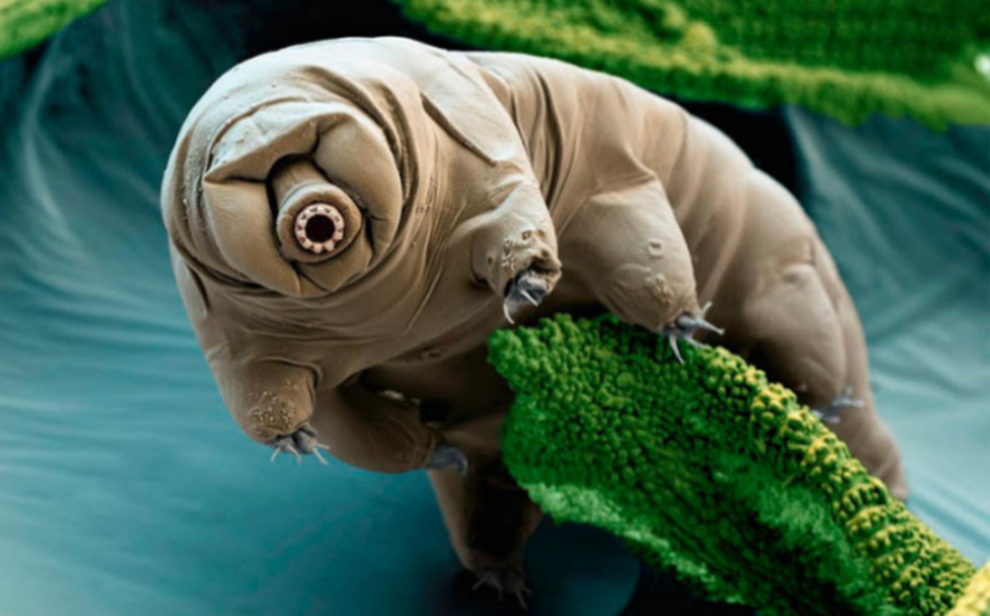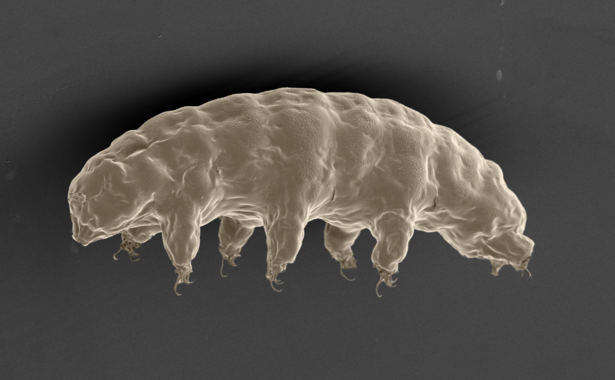The toughest animal on the planet is microscopic. Only measuring half a millimetre in length, they can be found everywhere, as they live in the water layer of mosses and lichens that encircles the globe. We are talking about the tardigrade, which in 1773 its discoverer, the zoologist Johann August Ephraim Goeze, called the “little water bear” because of its particular gait similar to that of these mammals. The mere fact that it walks is already unusual, as it is probably the smallest animal with legs. There are about 1,300 known species, which have lived separated from their closest evolutionary relatives for 500 million years. The tardigrade is one of the most fascinating micro-animals on the planet, and every time something new is discovered about it, the results appear in the most prestigious scientific journals. But what is it about this tiny animal that attracts such attention?
Superpowers. Some species of tardigrades can survive without water for years, perhaps decades, endure extreme temperatures from over 100 degrees Celsius to minus 272 below zero, withstand pressures of 6,000 atmospheres, survive radiation hundreds of times more powerful than the lethal dose for humans, and even tolerate prolonged exposure to the vacuum of outer space.

This last ability was proven when in 2007 European and Russian space agencies sent the Foton-M3 probe into space with a group of dehydrated tardigrades. The creatures not only survived, but retained their reproductive capacity. Since then, they have been recognised as the most resilient animals on the planet. In 2019, the Israeli probe Beresheet crashed into the surface of the Moon with a group of tardigrades on board, leading to speculation that they might be able to survive and reproduce there. However, one study showed that the legendary resilience of these little critters also has its limits: researchers fired them from a special hypervelocity gun to determine the collision speeds they could withstand. And although they survived up to about 3,000 km/h, the likely impact pressure on the Moon far exceeded their tolerance. In 2021, NASA sent tardigrades to the International Space Station to further investigate their resilience to extreme environments.
Surviving 30 years in deep freeze
One of the most interesting superpowers of tardigrades is their resistance to freezing and desiccation, as understanding how they achieve this could lead to a host of applications. In 2016, scientists at Japan’s National Institute of Polar Research succeeded in reanimating a tardigrade that had been frozen solid for more than 30 years at the South Pole, and the creature was even able to reproduce. The record broke the previous mark of nine years, although it has yet to match that of some nematode worms.
To survive the freezing, tardigrades enter a state of suspended animation known as cryptobiosis, a process by which they slow down all metabolic processes to 0.01% of normal and reduce their water content to 3% so that ice crystals do not destroy them. In this state, specialised proteins called IDPs— Intrinsically Disordered Proteins—form a kind of solid biological glass that maintains the animal’s structural integrity. Once conditions return to normal, the tardigrades rehydrate and regain full activity. Some scientists are exploring the possibility of applying PIDs to preserve at room temperature drugs or vaccines that normally have to be stored in extreme cold, such as certain COVID-19 vaccines.

The secrets of tardigrades began to come to light when, in 2015, a team of researchers from the University of North Carolina sequenced the genome of one species of tardigrade for the first time. The scientists believed then that one-sixth of their DNA came from other species and had been incorporated into the tardigrade genome by transfer, but it turned out to be bacterial contamination of the samples. The real surprise was to discover that these animals have eliminated genes that in other species cause damage in response to stressors, and instead possess unique genes that protect them from these stressors.
A gene shield against X-rays
A team from the University of Tokyo discovered in Ramazzottius variornatus (one of the most resistant species of “water bear”) a gene unique to tardigrades that could be the key to their resistance to radiation. The key is Dsup (Damage suppressor), an IDP-type protective protein that binds to the tardigrade’s DNA and wraps around it like a blanket, preventing damage from X-rays. Researchers found that this protein acts like armour. When applied to lab-grown human cells, they suffered up to 40% less damage from radiation.

A gene unique to tardigrades (Dsup) could be the key to their resistance to radiation. Credit: The Rockefeller University
The fascination of researchers with these little wonders of evolution has continued to surprise us with new findings. We have learned that only some species of tardigrades have eyes, and that they probably see in black and white; that one Antarctic species lays eggs so differently shaped that they appear to be designed on a whim; and that some protect themselves from the damaging effects of ultraviolet radiation by absorbing it and returning it in the form of blue fluorescence. In one of the strangest experiments to which these animals have been subjected, researchers at Nanyang Technological University in Singapore claimed to have achieved quantum entanglement between a tardigrade and a qubit, or quantum bit, although other scientists have dismissed as an exaggerated claim what they say is the simple interference of an object (the tardigrade) in an electrical circuit (the qubit) according to the classical laws of electromagnetism.
In short, it does not seem farfetched to predict that tardigrades will outlive humanity. A 2017 theoretical study concluded that only by boiling all the Earth’s oceans would they disappear. And yet it turns out that at the same time the only known Achilles heel of these tough little creatures is high temperatures; while they can withstand them, they greatly affect their survival, leading some scientists to warn that climate change could be a serious threat to them too. Tardigrades have survived five mass extinctions on Earth, but it remains to be seen whether they will survive a sixth human-induced one.
Comments on this publication